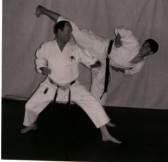|
Gichin
Funakoshi

Gichin Funakoshi (1886-1957)
was the founder of the Shotokan-ryu
style. Funakoshi was born in the Okinawan capital of Shuri into a
family of the Shizoku class (upper class). Master Gichin Funakoshi was
instructed by Yasutsune Azato and Yasutsune
Itosu. He was responsible for introducing
Karate to Japan in the 1920's. He was also responsible for changing (or
defining, depending how you look at it) the meaning of the word
Karate-do.
He changed the 'kara' symbol
in Karate from the old symbol, meaning 'China', to the new symbol,
meaning 'empty'. In his book Karate-Do Nyumon, he writes:
"Just as an empty valley can carry a resounding voice, so must the
person who follows the Way of Karate make himself void or empty by
ridding himself or all self-centeredness and greed. Make
yourself empty within, but upright without. This is the real
meaning of the 'empty' in Karate.
"...Once one has
perceived the infinity of forms and elements in the universe, one
returns to emptiness, to the void. In other words,
emptiness is none other than the true form of the universe.
There are various fighting techniques - yarijutsu ['spear techniques']
and bojitsu ['stick techniques'], for example - and forms of
martial arts, such as judo and kendo. All share an
essential principle with Karate, but Karate alone explicitly
states the basis of all martial arts. Form equals emptiness;
emptiness equals form. The use of the character [for
'empty'] in Karate is indeed based on this principle."
The result of this change is
that Karate-do, which formerly translated loosely to 'Chinese hand', now
translates to '[the way of the] empty hand'.
Chojun Miagi
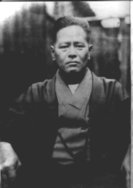 Chojun Miagi (1888-1953) was the founder of the Goju-ryu
style, "The way of inhaling and exhaling is hardness and
softness." Go means hard and Ju means soft. Since his style was a
combination of these ideals it became known as Goju Ryu 'hard soft way'.
In Goju-ryu much emphasis is placed on combining soft circular blocking
techniques with quick strong counter attacks delivered in rapid
succession
Chojun Miagi (1888-1953) was the founder of the Goju-ryu
style, "The way of inhaling and exhaling is hardness and
softness." Go means hard and Ju means soft. Since his style was a
combination of these ideals it became known as Goju Ryu 'hard soft way'.
In Goju-ryu much emphasis is placed on combining soft circular blocking
techniques with quick strong counter attacks delivered in rapid
succession
Chojun Miyagi was born in Naha
City, Okinawa on April 25th, 1888. He began training in karate under Kanryo
Higa'shi'onna in 1902. Because of his great natural talent and
fierce determination, he progressed very rapidly. Training was very
severe, with a lot of running and strength exercises. It is said that he
sometimes passed out performing Sanchin kata, so demanding was Sensei
Higaonna on his student's performance. He studied with his teacher for
14 years before his teacher’s death in 1915.
In 1915 he journeyed to Fuzhou,
China, the city where his teacher had studied the martial arts, to
further his own research. This was one of three trips he made to China
during his lifetime. On his return to Okinawa, he began to teach the
martial arts at his home in Naha. Later, he also taught at the Okinawan
Prefecture Police Training Center, at the Okinawan Master’s Training
College, and at the Naha Commercial High School.
In 1921, he was chosen to
represent Naha-te in a presentation to the visiting crown prince
Hirohito, and gave an impressive performance. He repeated this in 1925
for prince Chichibu. He began to visualize the future of the Okinawan
fighting arts, and in 1926, at the age of 38, set up the Karate Research
Club, along with Chomo Hanashiro (Shuri-te), Kenwa
Mabuni (Shito Ryu) and Choki
Motobu, spending the next 3 years training in basics, kata, fitness
and philosophy. Chojun Miyagi dedicated his whole life to karate. Every
waking moment was spent in pursuit of the art, always remaining
vigilante to his surroundings, always planning and ready for whatever
might occur.
The teaching system, which he
formulated, enabled karate to be taught in schools for the benefit of
the young people, and to reach vast numbers of people throughout the
world. However, his private teaching at his home remained strictly in
adherence to the principles and traditions of the teacher, Kanryo
Higa'shi'onna, and his teacher before him Ryu Ryu Ko.
In 1931, Goju-ryu
Karate-Do was officially registered in the Butokukai, the center for all
martial arts of Japan. This was a milestone for karate as it meant that
it was recognized on a level with the highly respected martial arts of
Japan. Chojun Miyagi died on October 8th, 1953, of either a heart attack
or a cerebral haemorrhage at the age of 65.
Ryusho Sakagami
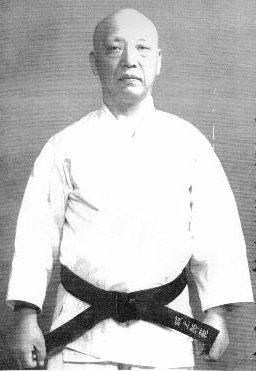 Ryusho
Sakagami (??-1994) was one of Mabuni's
early students. He established the Shito-ryu Itosu-kai organization, and
was appointed by Mabuni to the position of third generation head of
Itosu-ryu Karate-do. Sakagami became famous for his
knowledge of all Japanese Budo, and was regarded as a walking
encyclopedia of styles, lineage, technique, and kata
until his death. Ryusho
Sakagami (??-1994) was one of Mabuni's
early students. He established the Shito-ryu Itosu-kai organization, and
was appointed by Mabuni to the position of third generation head of
Itosu-ryu Karate-do. Sakagami became famous for his
knowledge of all Japanese Budo, and was regarded as a walking
encyclopedia of styles, lineage, technique, and kata
until his death.
Fumio Demura, a disciple of
Ryusho Sakagami and one of the most renowned component of Shito-ryu for
his exiteful eye-catching public demonstration of traditional Karate and
Kobudo, is running the Shito-ryu Itosu-kai in USA with the name of Japan
Karate Federation of America which was established in co-operation with
Dan Ivan of Shotokan.
In Japan, Sakagami's son
(Sadaaki) currently runs the Itosu-kai organization from Yokohama,
Japan.
In America, Shito-ryu Itosu-kai is run by Demura
under the name JKF America.
In Canada, Shito-ryu Itosu-kai is run by Kei Tsumura.
In Ireland, Shito-ryu Itosu-kai is run by Leo Mulvany.
Fumio Demura
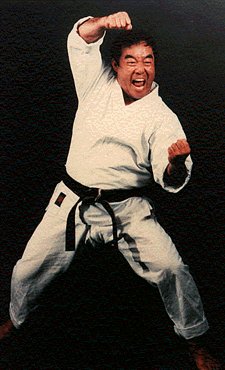 Fumio
Demura (??-) was a student of Ryusho
Sakagami. He is now in the USA, running the Shito-ryu
Itosu-kai with the name JKF America (which was established in
cooperation with Dan Ivan of Shotokan). Fumio
Demura (??-) was a student of Ryusho
Sakagami. He is now in the USA, running the Shito-ryu
Itosu-kai with the name JKF America (which was established in
cooperation with Dan Ivan of Shotokan).
Fumio Demura currently teaches
in his dojo in California. He currently holds the positions of
President/Chief Director of JKF International, Director/Chief Instructor
of JKF America, and Director/Chief Instructor of Shito-ryu, Itosu-kai
Karate-do (USA).
Besides teaching Karate,
Mr. Demura is the stunt man for Pat Morita in the Karate Kid
series of motion pictures, as well in the O'Hara televison series.
His other film credits include, Island of Dr. Moreau,
Bring 'Em back alive, and most recently Rising Sun
and Mortal Kombat. These are just a few of the
numerous films in which Mr. Demura has performed. For years
he was featured at the Japanese Village in Buena Park and in Las Vegas.
Today, he spends the brief time away that he takes from his Dojo
to demonstrate at Tournaments and Charity events. Demura has
been featured in many Martial Arts publications.
Hironori Ohtsuka
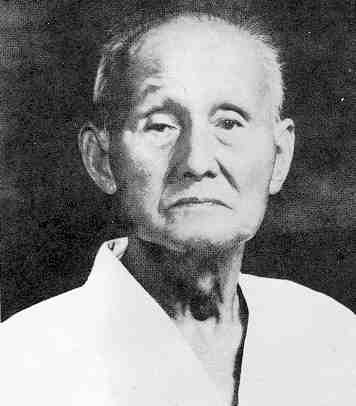 Hironori
Ohtsuka (1892-1982) was the founder of the Wado-ryu
style, and studied Shotokan under Gichin
Funakoshi. Wado Ryu karate was founded by Hironori Ohtsuka during
the 1920s and 1930s. Hironori
Ohtsuka (1892-1982) was the founder of the Wado-ryu
style, and studied Shotokan under Gichin
Funakoshi. Wado Ryu karate was founded by Hironori Ohtsuka during
the 1920s and 1930s.
Ohtsuka was born on 1st June
1892 in Shimodate City, Ibaraki Prefecture, Japan. At the age of 6 years
he began to study jiu Jutsu with his Grand Uncle. At the age of 13 he
started to study Shindo Yoshin Ryu Jiu Jutsu under a teacher named
Tatsusabaro Nakayama. Ohtsuka continued his studies whilst at Waseda
University. He received the award of menkyo (licence) in 1921.
Ohtsuka heard about a new
style of unarmed combat from Okinawa that had been introduced by Gichin
Funakoshi. That art was known as Karate. In 1922, Ohtsuka went to
visit Funakoshi in Tokyo to study karate. He received the rank of Shodan
in 1924 at the age of 31.
During his time training,
Ohtsuka developed the concept of pre-arranged sparring in which both
participants know in advance what attacks and defences are to be carried
out. The exercise could be considered to be a small two person kata for
developing skills and learning certain concepts - it is half way between
basics and applications.
Ohtsuka also continued his Jiu
Jutsu studies, and became a Shihan (teacher grade). He also began to
train with other great Karate masters such as Kenwa
Mabuni and Choki
Motobu.
At this time Ohtsuka
experimented with incorporating all his martial art skills into a new
form of Karate. Part of this experimentation was the introduction of
free-fighting practice. This conflicted with Funakoshi's view of Karate
and they parted company.
In 1938, Ohtsuka's new style
was accepted by the Dai Nippon Butoku Kai under the name of Wado Ryu.
Ohtsuka was also awarded the title of Renshi.
Development of Wado Ryu
continued after the Second World War, and in 1966 Ohtsuka was awarded
the Shiju Hoosho Medal from Emperor Hirohito.
Hironori Ohtsuka died in 1982,
shortly before his 90th birthday. Today, Wado Ryu is practiced all over
the world.
Choki Motobu
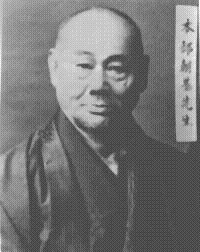 Choki Motobu (1871-1944) was born in 1871 in Akahira village in the
Shuri region of Okinawa. He was the third son of Motobu “Udun”, a
high ranking aji or lord. The Motobu family were skilled at the art of
Ti (a grappling art of the Okinawan nobility). Motobu did learn some of
the techniques of his family’s fighting system, but because of
Okinawan tradition, only the first son, Choyu, was educated and choose
to carry on the family’s martial tradition. Because of this situation,
he went looking for instruction elsewhere.
Choki Motobu (1871-1944) was born in 1871 in Akahira village in the
Shuri region of Okinawa. He was the third son of Motobu “Udun”, a
high ranking aji or lord. The Motobu family were skilled at the art of
Ti (a grappling art of the Okinawan nobility). Motobu did learn some of
the techniques of his family’s fighting system, but because of
Okinawan tradition, only the first son, Choyu, was educated and choose
to carry on the family’s martial tradition. Because of this situation,
he went looking for instruction elsewhere.
Choki began training
extensively with makiwara and lifted heavy rocks to gain strength. He
endeavored to become as strong as possible and trained with ferocity. He
became known as “Motobu zaru” or Motobu the monkey because of his
agility and speed. Eventually, Motobu became the student of Anko Itosu
(one of Mabuni’s sensei). Now a young man, Choki spent a lot of time
seeking out strong looking men to challenge on the street. He won most
of his fights and learned much from these encounters. Itosu sensei was
not impressed by the young man’s bullying and promptly expelled him
form the dojo.
Motobu’s aggressive behavior
soon earned him a bad reputation and many sensei would not teach him.
Once man, however, liked the spirit he showed and accepeted him as a
student of karate. This man was Kosaku Matsumura of Tomari. It was from
Matsumura that Choki learned many Kata. Motobu still challenged others
to fights often and was eager to develop and improve his fighting
skills. He eventually asked Matsumura to teach him kumite, but Matsumura
told him to continue to learn on his own. Motobu, however, was
persevering and is said to have watched the kumite training through
holes in the fence around Matsumura’s dojo.
Motobu’s street fighting
served him well (to the detriment of many). He formulated his own
formidable style of kumite and began to get much attention in Okinawa
and in Japan on his trips to the islands. One day while in Kyoto he
witnessed a contest where people were asked to match skills with a
foreign boxer. A friend coaxed Motobu to give it a try.
The boxer was arrogant and
goaded Motobu constantly. For two rounds Motobu just avoided the
boxer’s attacks. In the third round he had enough. He used a practiced
technique and promptly knocked the boxer out. The crowd was quite taken
aback. They had never seen this kind of fighting. Motobu had simply
struck his opponent with a fore knuckle in the temple; a basic
technique. Needless to say, Motobu quickly gained a reputation as a
master and many curious people came to learn this mysterious new art.
Soon, Motobu became a full time teacher.
During this time, Motobu
gained great respect for his fighting ability. He was hailed as the
greatest fighter in Japan. Many sensei advised their students to go and
train with Motobu and learn his kumite techniques ( for obvious
reasons). He was also asked to teach at several universities. Because of
this, many of today’s great instructors of various styles had the
benefit of his instruction, so it is clear that his was a large
influence in karate.
Motobu usually only taught
naihanchi kata to his students and it was his own version with many
Ti-like grappling and throwing techniques. However, it was his kumite
that had the greatest impact on karate. Oddly enough, there is a story
of Choki, full of confidence, challenging his brother Choyu to a fight.
It is said that Choyu threw Choki around like a rag doll. After the
experience, Choki is said to have humbled himself and adopted more of
his family’s Ti forms. In 1922, Master Motobu helped
Master Funakoshi
start the teaching of Karate to the Japanese. Filled with a new outlook
on his life, Master Motobu returned to Okinawa in 1936 and began
training with Master Kentsu Yabu. Master Yabu was only man
to have ever defeated Master Motobu.
Later in life, Motobu seemed
to stress the importance of tradition in training. He strongly stressed
the importance of makiwara training and became as enthusiastic about
kata as he had always been about kumite. In 1936, at the age of 65,
Motobu left Tokyo and went back to Okinawa to visit his instructors to
talk about the state of karate in Japan and to make sure that he was
teaching the kata and techniques in their originally, unaltered form.
Subsequently, he returned and continued teaching in Tokyo. Shortly
before World War II, he returned to Okinawa and died in September of
1944 of a stomach disease at the age of 73.
It is obvious that Choki
Motobu was very instrumental in the development of karate and that he
was the inspiration for many who trained in the art. It is good to see
that, today, millions of people still keep the art alive and strive to
keep the fighting spirit of karate which Sensei Motobu so dearly loved.
From The Coslet's Karate
Newsletter September, 1992
Kosei Kokuba
Kosei Kokuba, the father of
Shogo Kuniba, was the founder of Motobu-ha Shito-ryu.
Motobu’s teaching had a great impact on karate and especially on Kosei
Kokuba. Kokuba combined his learning from Mabuni and Motobu and created
Motobu-ha Shito-ryu karate.
Kosei Kokuba was born in Naha
City, Okinawa in 1901 the youngest son of a samurai family descended
from the Sho-Shi royal family of Okinawa. At the age of 14, he began
karate training in the dojo of Masto Choki
Motobu. In 1924 he moved to Tokyo, Japan and in 1940 he
settled in Osaka where he began training students in the Okinawan style
which he had studied. On June 6, 1943 Kokuba founded Seishin Kan Dojo.
Later, when his friends from
Okinawa, Motobu
and Kenwa
Mabuni came to Osaka, he gave them room and board in exchange for
their teaching at the Seishin Kan Dojo. He received training in Shito-ryu
karate from its founder Kenwa
Mabuni. Kokuba’s other instructor was Choki
Motobu. Kokuba taught the Motobu style of Karate and upon
Motobu’s death in 1947, he became the Soke or family head of Motobu-Ha
Karate-Do.
In Okinawa the Kanji
characters for Kosei Kokuba are pronounced as Kosei Kokuba but in
Japan, the same characters are pronounced as Yukimori Kuniba. To
avoid confusion he changed the pronunciation of the family name to Kuniba.
Shogo 'Soke' Kuniba
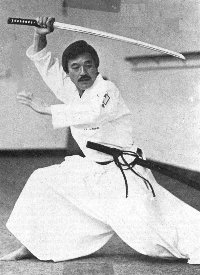 Shogo
Kuniba, the son of master Kosie
Kuniba was born on February 5, 1935 in Yamanashi prefecture
near Mt. Fuji in the city of Fuji-Yoshida-Shi. The son began his karate
training at the age of 5 in his father’s dojo. At the age of eight he
was sent to study with Tomoyori Ryusei of Kenyu Ryu. Master Kuniba
wanted his son to be a true samurai as were his ancestors and, as a true
samurai, of 8, Shogo also began to study judo in an Osaka Dojo. He
continued his training in Judo for ten years and earned a sandan rank. Shogo
Kuniba, the son of master Kosie
Kuniba was born on February 5, 1935 in Yamanashi prefecture
near Mt. Fuji in the city of Fuji-Yoshida-Shi. The son began his karate
training at the age of 5 in his father’s dojo. At the age of eight he
was sent to study with Tomoyori Ryusei of Kenyu Ryu. Master Kuniba
wanted his son to be a true samurai as were his ancestors and, as a true
samurai, of 8, Shogo also began to study judo in an Osaka Dojo. He
continued his training in Judo for ten years and earned a sandan rank.
In 1947 at the age of 12, he
bagan training with Master Mabuni in Shito-Ryu and was soon promoted by
Mabuni Sensei to Shodan in Karate. In 1950 he was promoted to Nidan by
Master Mabuni and Master Tomoyori and in 1952 earned a Sandan rank.
As a high school student,
Shogo was president of his karate club. At the age of seventeen, he
began teaching karate at Osaka Prefecture University and there is still
a branch dojo of Seishin Kai ther today. After high school, he trained
in Karate at Keio University and later trained at Doshisha University
while he was a student there.
In 1955 Shogo was promoted to
Yondan by Tomoyori Sensei. During that year he was also promoted to
Sandan in Iaiso and Yondan in Kobudo. In 1956 he traveled to his
father’s homeland of Okinawa where he trained with Master Nagamine
Shojin in this style of Shorin-Ryu. While in Okinawa, he studied Kobudo
with Taira Shinken and Nakaima Kenko of Ryuei Ryu. With Yamaguchi Junko,
he studied the use of the tonfa.
In 1983 he opened a Hombu Dojo
in the USA in Portsmouth, Va. He then concentrated his efforts on
teaching his style of karate-do to the world. The Seishin Kai is growing
in the USA and is now beginning to growing in the USA and is now
beginning to grow in Europe, Mexico, Israel, Sweden, South America and
the West Indies.
Soke Kuniba adhered to the
teaching and the philosophies of the Okinawan masters from who he is
descended. He believed and taught that the true goals of karate-do are
the development of patience, self-discipline, humility and inner
strength (ki).
Note:
It may be noted that Yasutsune
"Anko" Itosu and Kanryu
Higa'shi'onna are the two most important name in the history of
modern Karate-do. The four major style of Modern Japanese
Karate:- Shito-ryu, Shotokan-ryu, Goju-ryu, and
Wado-ryu, can be traced to them .
Kenwa
Mabuni (1887-1952), the Shito-ryu
founder, was a student of both Yasutsune "Anko" Itosu
& Kanryu Higashionna.
Gichin
Funakoshi (1886-1957), the Shotokan
founder, was a student of Yasutsune "Anko" Itosu (also
of Azato).
Chojun
Miagi (1888-1953), the Goju-ryu
founder, was a student of Kanryu Higashionna.
Hironori
Ohtsuka (1892-1982), the Wado-ryu
founder, was a student of Gichin Funakoshi, shotokan.
--------------------------------------------------------------------------------------------------------
Ki Training
ManualThis manual
is for the benefit of every good and honorable martial artist in this
world, so we can work together and learn to master the true power
within ourselves. For if we can master ourselves, we can be at peace
with each other. The art of war is also the art of peace, for only
those who experience war can truly understand it's evil. My work is
done in the hopes we will never have another war and that this
knowledge does more good than evil. Remember that everything that goes
around comes back around again. Consider yourself warned and never
abuse this knowledge.
*Any technique I
create here can be altered, for the only way to master ki is to become
independent of all other styles. You must create a way that feels
right to you. These can be a foundation for your own personal fighting
style.*
Disclaimer-Not
everyone is the same, so please keep this in mind and do not overexert
yourself. If you every feel sick in any way, discontinue these
exercises until it passes. If you constantly feel sick each time you
do these exercises, re-look these over to see if you made a mistake.
If you did not, try to lower the intensity in some way by making a
variation in an exercise. If that still does not help, discontinue
practice altogether and see a doctor, you might be sick. Also, do not
perform any intense exercises while sick or on mind-altering drugs or
medications, or if you are pregnant. Please use common sense.
Meditation to
store ki
Sit on the floor with your
legs crossed so that your ankles are touching. Then, cross your wrists
and grab the calf opposite of your arm. (I.e. right arm grabs left
calf.) The purpose of crossing your wrists and ankles is to hold or
contain the ki energy you are going to harness, so that it cannot
escape through the two openings of your body (palm of hands and soles
of feet).
Close your eyes and breathe
in through the nose and out the mouth. As you breath in, visualize the
earth's energy (in a green glow) coming into your body via a small
"gateway" in the base of your spine. Visualize the energy
vacuuming up into the swirling gateway and your abdominal area. Hold
the energy in your abdominal area as you hold your breath calmly. As
you hold the energy there, visualize it moving rapidly up and through
your body. It should travel through your chest and up to your brain.
Make sure it is traveling SLOWLY, as you do not want to force the
energy too much. You are simply directing it through your body. The
energy should also travel through your arms and legs. Basically, you
want it to fill your entire body.
When you can not hold your
breath any longer, empty your lungs and as you do so, visualize the
waste air leaving your body to be re-charged by the Earth. Repeat this
cycle, going each time slower and deeper as you do it. The energy you
develop here will be your "fuel tank" or "reserve"
energy that you will use when you practice a ki technique.
If your body starts to
vibrate, do not be alarmed. It sometimes happens and sometimes
doesn't. It depends on how much energy you are taking in. If you start
in any way to feel sick or odd, STOP performing this meditation until
the feeling goes away. Perform daily for maximum benefit.
Ki visualizing tech
(This technique was sent in by Chee Fatt at sifuhiu@tm.net.my )
Chi is your life force
energy. It is an extension of your body much like your arms and legs.
The only real difference between your arms and your ki is that your ki
is not activated by sub conscious thought.* You must visualize what
you want the ki to do. This is why a visualizing tech is needed.
Think of visualizing as your
intention. You must be much like an artist- you will "draw"
in your mind what you desire the ki to do, using your imagination.
Also, remember that your very will IS the ki. But it should not be an
order. Do not force your ki. "You can bring a horse to the water
but you can't make him drink." is an old saying can be likened to
ki. You can tell it what to do and make it a strong order, but if your
ki is not able to do the desired effect it will not. It may take quite
a lot of practice to always gain the desired effect, but it will
eventually come.
For starters, you should use
a stance familiar to you (the guarding or fighting stance in your art
is usually best), relax, and imaging there are powerful forces pulling
and pressing from all directions. The most important ones are the 2
imaginary opposite forces running from your spine. One pushing up from
your head to the heaven and the other down stamping into the earth.
Maintain in the posture fully relax for 5 minutes and work your way up
gradually Loosen-up when you feel tense.. Very soon you will find chi
bursting-out and your whole body inflated. This is `Wu Chi' (Ultimate
emptiness manifesting Yin/Yang). Try it, you will feel the difference
and in just 1 week you will notice significant increase in chi. After
3 months with 10 minute practice sessions daily, you will be amazed
how powerful you're ability to activate ki will have become.
*Ki will eventually be under
your sub conscious control with practice, as any other martial art
tech does after repeative use.
Ki ball construction
(this exercise was adapted from the Psion Guild's psi ball exercise)
Ever seen a japaneese anime
cartoon where a character, such as Ryu on Street Fighter, creates a
ball of ki in their hands to perform a ki blast? Well, a ki ball can
actually be created. Practicers of a psychic art form, called Psionics,
start their training by learning an energy maniulation and
transformation technique called the Psi Ball. Since psi and ki energy*
is technically the same thing, a ki ball can also be created.
A ki ball is used for two
reasons other than for attack- energy manipulation and energy
transformation. The first reason, energy manipulation, is another way
for your body to become acustomed to using ki energy, much like the ki
visualization tech does. The only real difference is that you are
going to have more options to use the ki for, and martial purposes is
one. The other difference is that a ki ball will teach you ki
transformation which can if nothing make your body use ki more
effeciently. I will focus on ki transformation in a little while, but
first I want to tell you how to make a ki ball.
First, you should ground
yourself. Then once grounded, pull energy up into you from the Earth
and channel it through your arms toward your hands. Couple your hands
like you are holding an invisible baseball or tennis ball. Imagine
that the energy is going through your hands and swelling into a ball
in the middle of your hands. Let it swarm, constrain, and become more
powerful as you add more power to it. You should feel the power in
your hands as a "tingling" or as I like to say, a
"vibrating" feeling. If you cannot feel the energy, try
adding more power to it. You will not be able to see the ki ball from
the start. Hopefully, as you become more adapt at making a ki ball,
you will create one that is powerful enough for you to see*1.
Now for the fun part; ki
manipulation. Basically, you are going to change the ki ball into
something more exotic or different. Maybe you'd like to imitate a
favorite anime and change your ki ball into a sphere or flame of ki.
Perhaps you'd like to toss the ki ball back and forth between your
hands. You can create anything your imagination can conceive from your
ki ball as long as you can see what you want clearly and you focus on
the object.
* Psi and ki are different
usages of life force energy. They are composed of the exact same
thing, life energy, but the two are not the same. Ki energy can be
combined with the physical body while psi energy cannot. However, ki
energy is not as powerful psychically as psi energy is. More on this
later.
*1 Your "third
eye" must also be trained before you will see anything, although
a ki ball is part of the training for the third eye as all ki usage
is.
Experimental
Exercise to perform a low level Ki blast
Focus your ki through your
target using your eyes and mental image. Tighten every muscle in your
body, and while doing this, imagine your ki focusing into your body
and radiating. This energy will travel up into your hands. Perform a
double open handed strike from the center of your abs, and when you
want to release the ki, tighten your hands while stretched out as hard
as you can. While the hands are tightened, focus the ki as a
destructive force that will harm your target, pushing it back as your
blast reaches it, then going through it. Perform this movement as fast
as you can.
All techniques use the ki
you have stored, so do not drain yourself with overdoing these
practices. It will take time and hard effort to train your body to
absorb and transmit ki efficiently (that is why the masters are so
old) so does not be discouraged. Every one has a different level of
power they are born with, but all have the potential to achieve
"super-human" energy level, where legend has it you can
become immortal.
Experimental
exercise to create a low-level psychic shield.
There are three ways
to do this- and should be practiced in the presented order-
Level One Exercise-
Before a ki storage
meditation, imagine an energy shield surrounding your body from five
inches away. It should contain your astral self (if you've haven't
heard about this, learn) and all of your energy. Constantly imagine
this shield around your body, blocking any other energies except the
ones you want to let in (earth energies which will come from below).
It will protect you from other ki also. It will stop your ki from
being drained by one who can drain ki. It will protect you entirely
from a psychic perspective. It will also contain any energy you charge
up. You must visualize this shield around you as a colored energy and
closing your eyes helps. A dark color, such as green, purple, or red
will work. DO NOT USE A LIGHT COLOR!!! Dark colors will bounce energy
away, while lighter colors will not only let energy through, it will
also enhance them. When you can put your shield around you without
closing your eyes, move on to level two.
Level Two Exercise-
During the day, tighten your
psychic shield around you the whole day. You will not get this right
away, so be patient and practice. Keeping your shield around yourself
for a full day is your ultimate goal in this exercise. This will train
you to keep your shield around you subconsciously, so it is extremely
important that you master this before moving on to level three.
Level Three
Exercise-
WARNING- This is an
experimental exercise that I am not sure will work, so the effects are
entirely on speculation. If you practice this exercise, you are
putting yourself at possible psychic and physical threat. Use your
head with this one.
The goal of this exercise is
to learn to block powerful psychic attacks, including those that
utilize ki. First, start with putting your shield around you and a
friend throw "negative thoughts" at you. They are going to
try and cause some sort of harm to you on a psychic level, possibly on
that of a low physical one (headache, stomachache). You must imagine
stopping these energies with your shield, and if you feel necessary,
deflect them back at your friend. Be cautious.
Next, you must practice
blocking ki with your shield. Have your friend throw low-level ki
blasts at you, extremely light. You are going to look past him/her and
strengthen your shield with your ki, and block or stop it. Again, you
can even deflect it back at him/her. Be cautious.
The last one is creating a
force field around you, that no one or thing can penetrate. This
shield can go extend around you for at least two yards, possibly more.
You will sit down, cross your legs and meditate. While meditating,
imagine a force field around your body for two yards, harming any who
try to penetrate it. It will stop them and block them from coming in.
Focus hard and use your ki to create it. You will need another person
to try and enter this force field to know if it will work or not. Be
cautious, for this is a defensive and offensive technique and can harm
someone.
Ready charge-
This is a reaction charge.
It will increase your awareness of all attacks at you. Very useful
when you think you might be attacked. Simply visualize your energy
surrounding you, ready for you to use in an incredible attack of speed
and strength. Watch everything around you carefully and from the
corner of your eyes. Use Kung-Fu technique "soft eyes" (not
looking at target) to watch everything around you.
Tips on using ki for
fighting
(submitted by Chee
Fatt)"The ultimate fighting emotion is not violence, strangely,
it is compassion with a steady awareness. Try it in your sparring
session, you will realize this truth." These
techniques have been created by me, MisteryShadow, unless otherwise
noted, and can be distributed as necessary as long as a link is made
back to my page. Those that are otherwise posted are to be asked
before used.
Understanding Ki
In order for you learn ki,
it is essential that you understand it. Therefore, I have compiled a
short lesson that will help you establish a foundation for
understanding how ki works. The first you must learn, is the Theory of
Yin-Yang.
Yin-Yang Theory
"The yin is the ancient
Chinese feminine principle and the yang is the masculine; together,
they represent universal complementary opposites, dualities. The yin
comes before the yang because it is the primordial darkness that
exists before the lightness of creation Yin is the Earth, Yang is the
Heavens"
This means that there are
two main elements that control all other forces in the Universe. Yin
represents darkness, emotion, and strength. Yang represents light,
thought, and defense. Yin has long been associated with feminine and
evil, while Yang has represented masculine and good. However, I do not
follow that belief, since I see that you cannot attack without having
an evil nature based on this belief. Attacking is not evil; it is not
that simple. It is impossible to defend oneself against another
without attacking. That is not evil, it is good. You cannot fight for
what you believe in or protect others without yin. Evil cannot be
classified that easily. The belief that darkness is evil is also
undeserved, because that would mean at night, the world is covered in
evil. Very odd, since many, including myself, enjoy the nighttime for
it's romantic gleam and mystery. I for one am not afraid of the dark,
especially when there are worst things to fear like taxes. Also, if
Yang represents good and male, does that make woman (Yin) an evil
creation? No, it does not for evil and good cannot be limited to any
classification of any type. They depend on circumstances of events,
not systematic definitions.
Here is some more depth on
Yin-Yang to help you understand it's importance-
"The essentials of the
yin-yang school are as follows: the universe is run by a single
principle, the Tao, or Great Ultimate (also known as God or Void).
This principle is divided into two opposite principles, or two
principles, which oppose one another in their actions, yin and yang.
All the opposites one perceives in the universe can be reduced to one
of the opposite forces. The yin and yang accomplish changes in the
universe through the five material agents, or wu hsing , which both
produce one another and overcome one another. All change in the
universe can be explained by the workings of yin and yang and the
progress of the five material agents as they either produce one
another or overcome one another. Yin-yang and the five agents are, I
need to stress, a universal explanatory principle. All phenomena can
be understood using yin-yang and the five agents: the movements of the
stars, the workings of the body, the nature of foods, the qualities of
music, the ethical qualities of humans, the progress of time, the
operations of government, and even the nature of historical change.
All things follow this order so that all things can be related to one
another in some way: one can use the stars to determine what kind of
policy to pursue in government, for instance.
The yin and yang represent
all the opposite principles one finds in the universe. Under yang are
the principles of maleness, the sun, creation, heat, light, Heaven,
dominance, and so on, and under yin are the principles of femaleness,
the moon, completion, cold, darkness, material forms, submission, and
so on. Each of these opposites produces the other: Heaven creates the
ideas of things under yang, the earth produces their material forms
under yin, and vice versa; creation occurs under the principle of
yang, the completion of the created thing occurs under yin, and vice
versa, and so on. This production of yin from yang and yang from yin
occurs cyclically and constantly, so that no one principle continually
dominates the other or determines the other. All opposites that one
experiences-health and sickness, wealth and poverty, power and
submission-can be explained in reference to the temporary dominance of
one principle over the other. Since no one principle dominates
eternally, that means that all conditions are subject to change into
their opposites.
This cyclical nature of yin
and yang, the opposing forces of change in the universe, mean several
things. First, that all phenomena change into their opposites in an
eternal cycle of reversal. Second, since the one principle produces
the other, all phenomena have within them the seeds of their opposite
state, that is, sickness has the seeds of health, health contains the
seeds of sickness, wealth contains the seeds of poverty, etc. Third,
even though an opposite may not be seen to be present, since one
principle produces the other, no phenomenon is completely devoid of
its opposite state. One is never really healthy since health contains
the principle of its opposite, sickness. This is called "presence
in absence." Once you have this principle down, the particular
Chinese view as expressed in literature, art, and history will become
immediately evident."
Now, let us look at Ki
directly-
Ch'i (Chinese) or Ki
(Japanese) is the internal force in our bodies, the manifestation of
our spirit. The source of this power is the Tan Tien (Chinese) or Hara
(Japanese). This Tan Tien is located about 3" below the navel,
and in the center of our bodies. Not so coincidentally this is also
where the center of balance for the average human is. The name comes
from the idea of "center", and represents our center; center
of the spirit, soul, power, and balance. There is a physical center,
and a center of balance -- so describing that as a "spot"
Tan Tien) is a convenient construct for understanding.
While it is convenient to
dismiss this construct, we should not do so too quickly. There is a
physical center of balance -- pretending that it is something more may
have its benefits. You may not believe in an "power" running
through your body, or a spirit/soul. You may not believe in the Tao -
the power of nature existing everywhere (westerners might call this
the holy ghost). But always remember that faith healers do help some
people. Placebo's are also very beneficial. Visualization in martial
arts and sports does cause an increase in performance. So think about
it before you dismiss it.
In the case of acupuncture,
accupressure, shiatsu massage, and other oriental medicine, the body
is not as broken down into component parts as much as it is looked at
interlocked systems, and balanced as a whole. In Oriental medicine
there are pressure points or trigger point that stimulate different
systems, and by balancing the energies (Yin and Yang) in these systems
you can tune the whole. These energies (Yin and Yang) collectively are
the Ch'i or Ki in our body, and it is this flow of life force through
our body that keeps us healthy. There is another force that runs
through all things in nature (and is nature itself), this is partly an
explanation of the Tao (or Taoism).
Many Asian cultures seem to
look at the world much more holistically than westerners. Things
interact as complex systems, and through understanding the whole, they
try to understand the parts. This is why the Japanese can use a
mundane task like archery as a way to understand Zen Buddhism (and
themselves). They are trying to understand things (life) by grasping
the whole. Not fighting to learn, or challenging, sometimes just
existing until understanding comes on its own.We westerners tend to be
more deconstructive -- always trying to break things down into its
component parts -- then understanding the parts. Then later we try to
look at all those component parts and see how they relate to the whole
(reconstructing). They are different ways to look at the world. The
more I have tried to understand the Oriental perspectives, the more I
have learned about myself. But that sounds suspiciously oriental in
its holistic outlook.
In the oriental medicines,
they have designated systems or organs in our bodies that
scientifically don't exist (as defined). Yet, stimulating these
nonexistent organs (systems) gets the desired results anyway. So while
western medicine and science can disprove the existence of organs like
the preheater, etc., manipulating that construct still gets the
desired results in many cases. So surprisingly, even if the construct
is wrong (inaccurate), it does not mean that the results will be
wrong. Ancients though that the sky was painted on, and spinning above
us as a ceiling -- yet they still accurately mapped the constellations
and predicted many astrological events. Even Western medicine also
doesn't always agree with itself -- as in Chiropractors, etc., but
their are many that have received the real and physical benefits of
these "charlatans". As time progresses the scientific
community is learning that there are results that can not always be
explained. The Chinese and to a lesser extend the Japanese are a
mystical people. Many Orientals have chosen to define these results
with a mystical definition, and though all the definitions might not
be accurate, results are results.
Our entire system of math
and science is based on (or is just a collection of) many HUMAN
constructs. Einstein's theory of relativity or the speed of light is
not some immutable law. It is an observation and construct of man to
explain relationships. It may accurately match the universe we live in
(or maybe not) but for now, these constructs (called laws or theories
of science) do help us understand and grasp problems. Even our laws of
science have changed (been revised) as we learned more, so our
constructs are not flawless -- we need to balance skepticism and
scientific theory with an understanding of who and what we are.
The more scientific
definition of Ch'i is based on some interesting facts. We (humans)
have an amazingly complex electrochemical and electromagnetic system
in our bodies (nervous system). By training our brains and bodies to
utilize our nervous system and muscles to their full potential, and
using technique, visualization and proper use of energy, we are able
to do incredible feats. Since we don't understand the full effects of
this electrical, chemical or magnetic energy, we don't understand its
limitation. So the feats of Ch'i that are seen as "magic"
are not impossible, just not fully understood. Many Ch'i
demonstrations are parlor tricks, but there is a percentage that is
not. Using visualization, timing, coordination, training and body
mechanics, it is quite possible for anyone to hit harder than other
non-martial artist or do other "tricks". For Americans, it
is explained best to us in constructs that we understand (physics,
training, timing, visualization) - The Chinese just describe it as a
good use of Ch'i. There are elements to this "power" that I
do not understand -- but understanding it is not necessary for
utilizing it. Just like a complete understanding of astrophysics was
not necessary for ancients to create calendars and predict the
seasons, phases of the moon, or track the planets.
I hope now you can
understand the concept of ki better, now that you have been exposed to
the more common knowledge of it. By knowing the concepts of ki, you
can not only perform the exercises more efficently, but you can also
create your own. For example, by knowing that ki resides in your
abdominal area, you can start your most powerful strikes from that
area, and gain better access to ki. By applying science to that, you
also see that not only are you adding ki, but gravity if you lower
your hips and knees as you strike. You can create a powerful combo of
your body mass, gravity, speed, muscular strength, and ki. Quite a
powerful strike indeed. Also, by knowing vital areas, such as the
kidneys or liver, and perform the strike, you can gain even better
results for these areas are less resistant to your energy and can more
efficently and will create more damage to your opponet. Constantly
learn as much as possible to increase your abilities; for knowledge is
the true power that is the foundation for every act you will every
make in your entire life.
|
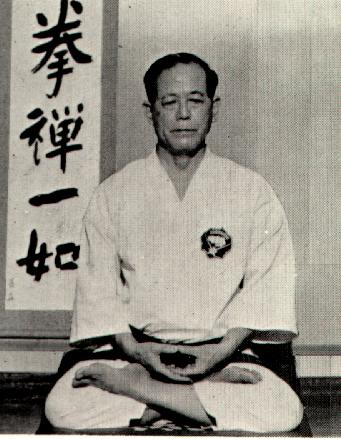
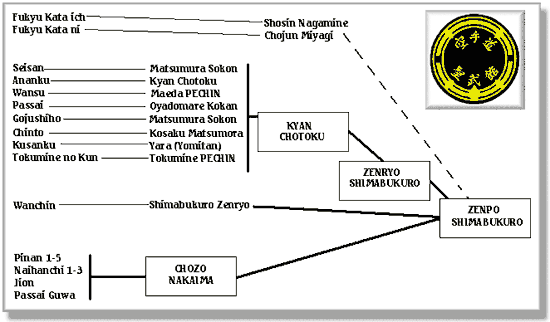

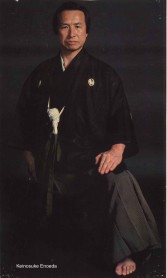
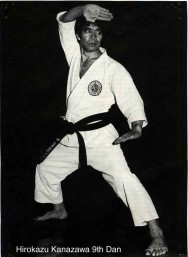
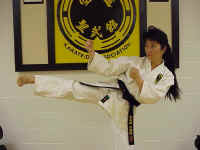
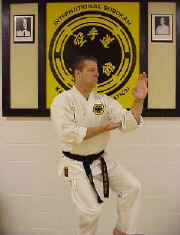
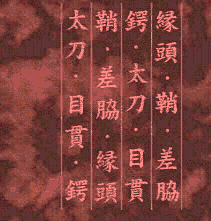
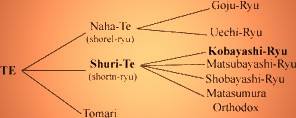
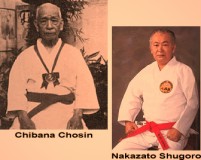
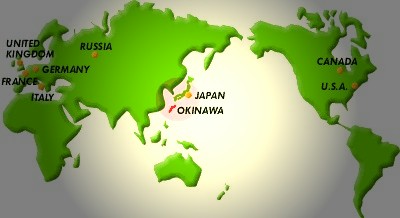

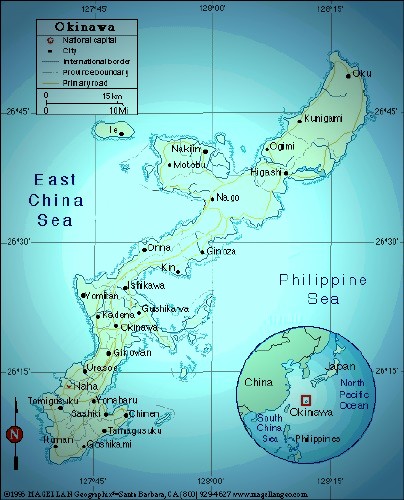
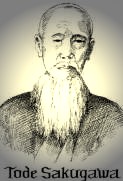

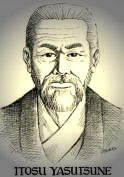
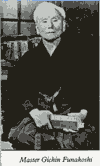
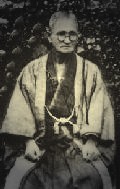
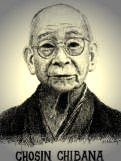
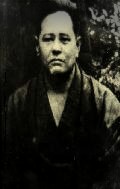
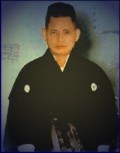
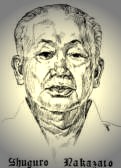
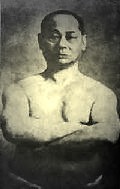
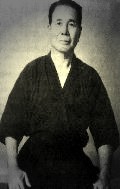
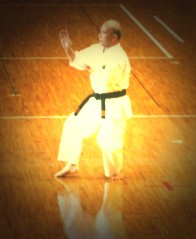
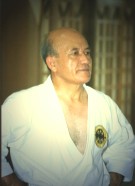
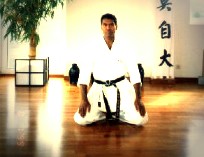
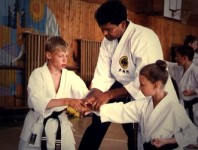


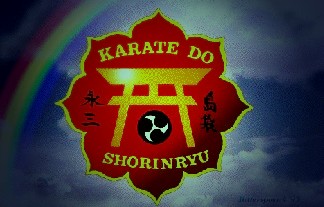
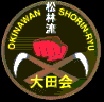
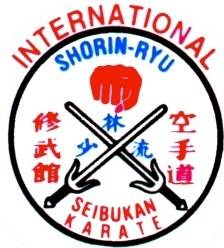
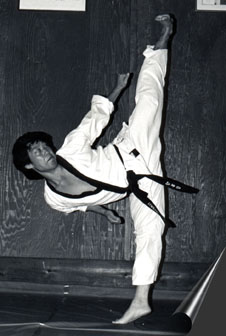
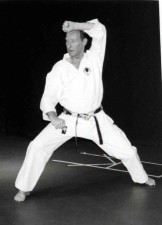
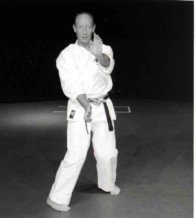
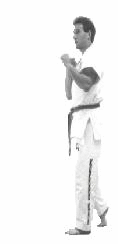





 Choki Motobu (1871-1944) was born in 1871 in Akahira village in the
Shuri region of Okinawa. He was the third son of Motobu “Udun”, a
high ranking aji or lord. The Motobu family were skilled at the art of
Ti (a grappling art of the Okinawan nobility). Motobu did learn some of
the techniques of his family’s fighting system, but because of
Okinawan tradition, only the first son, Choyu, was educated and choose
to carry on the family’s martial tradition. Because of this situation,
he went looking for instruction elsewhere.
Choki Motobu (1871-1944) was born in 1871 in Akahira village in the
Shuri region of Okinawa. He was the third son of Motobu “Udun”, a
high ranking aji or lord. The Motobu family were skilled at the art of
Ti (a grappling art of the Okinawan nobility). Motobu did learn some of
the techniques of his family’s fighting system, but because of
Okinawan tradition, only the first son, Choyu, was educated and choose
to carry on the family’s martial tradition. Because of this situation,
he went looking for instruction elsewhere.
